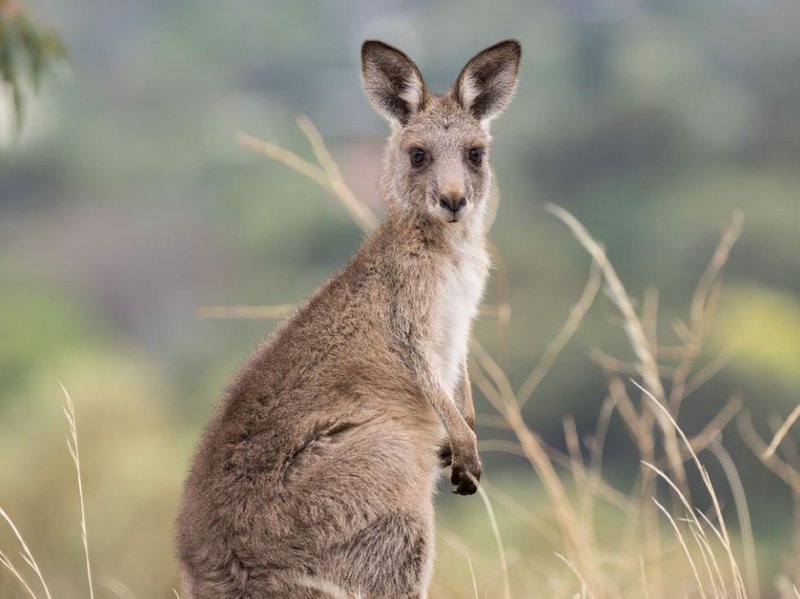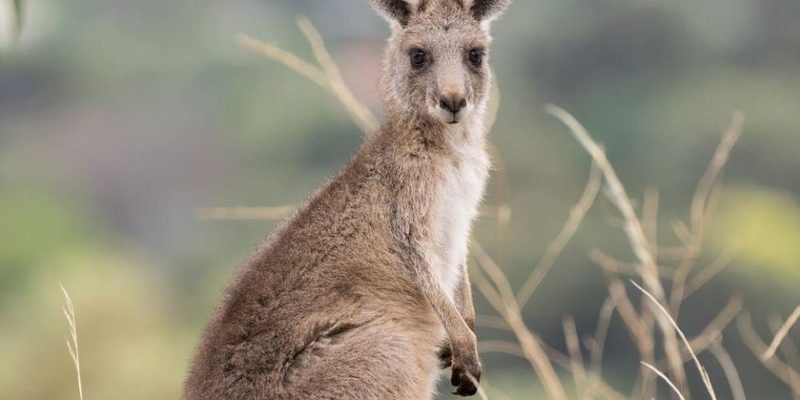
Think of the eastern grey kangaroo like a natural gymnast—it’s agile, strong, and has some pretty impressive tricks up its sleeve. They can leap great distances and navigate their way through complex terrains with ease. Plus, their social structures and habits reveal a lot about their lives in the wild. So, whether you’re an animal lover or just curious, you’ll find something to marvel at in these fascinating facts.
1. A Unique Species of Kangaroo
The **eastern grey kangaroo** (Macropus giganteus) is one of the largest kangaroo species, and it’s certainly distinctive. These kangaroos are often recognized by their long, powerful hind legs and a large, muscular tail. Their fur is usually a soft grey color, giving them their name, and they can grow up to 8 feet long if you include their tail! To put that into perspective, that’s about the length of a compact car!
In addition to their size, eastern grey kangaroos are particularly known for their comfortable posture. When they’re resting, they often sit on their hind legs, leaving a cute image that many find endearing. Honestly, watching them lounge around is like seeing a child sprawled out on the floor after a long day of play!
2. Their Diet is Quite Diverse
You might be surprised to learn that eastern grey kangaroos are herbivores. Their diet primarily consists of grass and leaves, but they enjoy a mix of other plants too. They have a special digestive system that helps them break down tough plant fibers. Imagine having your own built-in blender that helps you eat salads!
These kangaroos are also pretty picky about their food. They tend to graze on the freshest and most nutritious plants available. To find that perfect meal, they may travel several miles each day. Just think: they’re like the ultimate foragers in the wild, always on the hunt for the tastiest grass!
3. Remarkable Jumpers
Eastern grey kangaroos are famous for their incredible jumping abilities. They can leap up to 10 feet high and cover distances of up to 30 feet with a single bound! This is not just for show; it’s a smart way to escape predators and navigate their environment. If you’ve ever tried to jump over something, you know how tough it can be. Now imagine doing that with a strong gust of wind at your back!
Here’s the thing: kangaroos use their powerful hind legs not just for jumping, but also for walking. They move in a unique way called “saltation,” which means they hop instead of walk. It may look playful, but it’s an energy-efficient way for them to get around. How cool is that?
4. Social Animals with Strong Bonds
Kangaroos are not solitary creatures; they often live in groups called “mobs.” These mobs can consist of anywhere from a few kangaroos to over 100! Being social animals, they establish bonds with one another, and the younger kangaroos often learn from their older counterparts. Imagine a group of friends hanging out at a park—playing, grooming each other, and generally enjoying their time together.
These social dynamics help them stay safe. When one kangaroo senses danger, it can alert the others, and they all hop away together. It’s teamwork in action! This social structure not only helps with protection, but it also fosters a sense of community among them.
5. A Unique Way of Reproduction
Eastern grey kangaroos have a fascinating approach to reproduction. Female kangaroos have a special pouch where they carry and nurse their young, known as joeys. A baby kangaroo is born tiny—about the size of a jelly bean—and immediately crawls into its mother’s pouch for safety and nourishment. It’s a bit like carrying a purse around, but with a living baby in it!
Joeys stay in the pouch for several months, growing and developing until they’re ready to face the world. This unique reproductive strategy gives them the best chance of survival, especially in the wild where dangers lurk. Honestly, it’s a heartwarming sight to see a joey peeking out of its mother’s pouch, curious about the world around it!
6. Adapted to Australian Conditions
Living in Australia means eastern grey kangaroos have adapted to survive in tough environments. They can handle hot temperatures and have developed behaviors to stay cool during the heat. For instance, they like to rest in the shade during the hottest parts of the day and are active during the cooler mornings and evenings.
Their ability to conserve water is also impressive. Eastern grey kangaroos can go for long periods without drinking, often getting the moisture they need from the plants they consume. It’s a clever survival strategy that shows just how resilient these creatures can be!
7. Communication Skills
Kangaroos have their own ways of communicating, and it’s not just about hopping or cuddling. They use different sounds to express themselves—like grunts or cough-like noises when feeling threatened or calm. These vocalizations help them stay connected with their mob.
Body language is also key. When a kangaroo thumps its hind foot on the ground, it’s signaling alarm to others nearby. Think of it as their version of sending out a group text to let everyone know there’s something to be cautious about. It’s amazing how in tune they are with each other, right?
8. Regulated by Conservation Efforts
Like many wildlife species, eastern grey kangaroos face challenges due to urbanization and habitat loss. Fortunately, conservation efforts are in place to help protect their population. National parks and reserves provide safe spaces for them to thrive without the threat of human encroachment.
In some areas, management practices are implemented to ensure their population remains balanced, allowing for both the kangaroos and the ecosystems they inhabit to flourish. It’s like having a team of wildlife stewards working tirelessly behind the scenes to safeguard our furry friends!
9. They Can Live for Over a Decade
Eastern grey kangaroos typically live for about 10-12 years in the wild, though some can live even longer in captivity. Their lifespan can be influenced by various factors, such as food availability, predation, and environmental conditions. In the wild, they face challenges like droughts and habitat changes, but they adapt remarkably well.
Imagine the stories they could tell if only they could speak! They experience the highs and lows of life in the Australian bush—bouncing back from hardships and thriving amidst beauty.
10. Cultural Significance
In Australia, the eastern grey kangaroo holds a special place in the hearts of the locals. They feature in Aboriginal culture, art, and folklore. These kangaroos symbolize strength, adaptability, and the spirit of the land. It’s clear that they’re more than just animals; they are integral to the identity of Australia.
Even in modern times, the image of the kangaroo is iconic, representing everything from wildlife conservation to sporting teams. You might even find a kangaroo mascot at a local sports event! This connection showcases how deeply intertwined they are with Australian culture.
In conclusion, the eastern grey kangaroo isn’t just a fascinating animal; it’s a symbol of resilience and community in the wild. Their unique characteristics and behaviors make them truly captivating. Next time you think of kangaroos, remember these intriguing facts and appreciate the wonder of nature that they embody.

